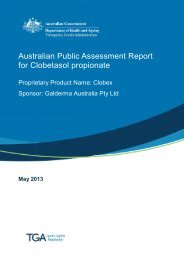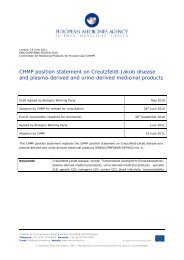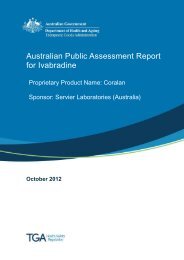Australian public assessment for Ibuprofen - Therapeutic Goods ...
Australian public assessment for Ibuprofen - Therapeutic Goods ...
Australian public assessment for Ibuprofen - Therapeutic Goods ...
You also want an ePaper? Increase the reach of your titles
YUMPU automatically turns print PDFs into web optimized ePapers that Google loves.
III. Nonclinical findings<br />
Introduction<br />
General comments<br />
AusPAR Caldolor <strong>Ibuprofen</strong> Phebra Pty Ltd PM-2010-02393-3-1<br />
Final 2 January 2013<br />
<strong>Therapeutic</strong> <strong>Goods</strong> Administration<br />
The toxicity profile of ibuprofen has been previously characterised and there is extensive<br />
clinical experience with its use. In order to justify the new route of administration, the<br />
sponsor submitted bridging studies, which included two 28 day IV toxicity studies (with<br />
toxicokinetic data), blood compatibility studies and local irritation studies. The general<br />
quality of the submitted studies was good. Pivotal studies examining the repeat-dose<br />
toxicity were conducted under Good laboratory Practice (GLP) conditions. Additional<br />
submitted studies included dose range-finding IV studies and published repeat dose<br />
toxicity studies in rats (oral (PO)), dogs (PO) and monkeys (IV/PO), single dose toxicity<br />
studies, genotoxicity studies and reproductive toxicity studies.<br />
The proposed maximum recommended human dose (MRHD) is 3200 mg/day, there<strong>for</strong>e a<br />
50 kg patient receiving the MRHD would receive 64 mg/kg ibuprofen. The MRHD <strong>for</strong><br />
ibuprofen administered orally is 2400 mg/day.<br />
Studies in the submitted published literature which were not per<strong>for</strong>med with IV ibuprofen,<br />
or with the proposed <strong>for</strong>mulation, were not assessed.<br />
Pharmacology<br />
Mechanism of action<br />
Like that of other NSAIDs, ibuprofen’s mechanism of action is not completely understood<br />
but may be related to inhibition of cyclooxygenase mediated prostaglandin <strong>for</strong>mation.<br />
<strong>Ibuprofen</strong> possesses anti-inflammatory, analgesic, and antipyretic activity. <strong>Ibuprofen</strong><br />
inhibits both COX-1 and COX-2 activities and thereby synthesis of prostaglandins and<br />
thromboxanes. The inhibition of COX-1 is believed to be responsible <strong>for</strong> the<br />
gastrointestinal (GI) adverse effects related to ibuprofen administration 1.<br />
No pharmacodynamics studies were submitted and this was considered acceptable as<br />
there is extensive clinical efficacy data from clinical experience with ibuprofen.<br />
Pharmacokinetics<br />
In the submitted dog studies, oral administration of ibuprofen resulted in lower plasma<br />
drug concentration and overall exposure (50-60%) when compared with IV<br />
administration at the same dose level. In the two clinical studies in which equal IV and PO<br />
doses were compared (Table 1), plasma area under the plasma concentration time curve<br />
(AUC) values were similar, indicating 100% PO bioavailability under the conditions of<br />
these studies.<br />
In general, all measured parameters were similar between genders and sampling days.<br />
AUC and peak plasma concentration (Cmax) values were dose proportional <strong>for</strong> both males<br />
and females on both sampling days and no clear sex differences in systemic exposure were<br />
1 Insel PA. Analgesic-antipyretic and anti-inflammatory agents and drugs employed in the treatment of<br />
gout. Chapter 27. In: Hardman J. G. and Limbird L. E. The Pharmacological Basis of <strong>Therapeutic</strong>. Mc Graw<br />
Hill, 1990: 617-658<br />
Page 6 of 118
















